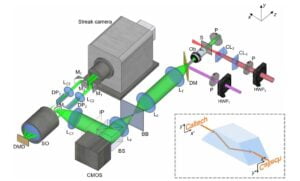ButSpeak.com
News which Matters.

Key Points:
Over a year ago, Lihong Wang, a professor at Caltech, stunned the scientific community with a camera capable of snapping 10 trillion frames per second, capturing light in slow motion. However, Wang realized that speed alone wasn’t sufficient; the camera needed to capture what was previously invisible.
To address this, Wang, the Bren Professor of Medical Engineering and Electrical Engineering, has developed a new camera that can take up to 1 trillion pictures per second, focusing on transparent objects. This groundbreaking innovation, detailed in Science Advances, opens new frontiers in visualizing the unseen. Wang’s latest invention, phase-sensitive compressed ultrafast photography (pCUP), can photograph transparent materials and fleeting phenomena like shockwaves and potentially even neural signals.

This advanced imaging system combines high-speed photography with phase-contrast microscopy, a technique invented by Dutch physicist Frits Zernike over a century ago. Phase-contrast microscopy utilizes the varying speeds of light as it travels through different materials. For instance, when light passes through glass, it slows down and then speeds up as it exits. This change in speed affects the light wave’s timing. By making specific optical adjustments, scientists can distinguish light that has passed through glass from light that hasn’t, making the transparent material visible.
“What we’ve done is to adapt standard phase-contrast microscopy so that it provides very fast imaging, allowing us to image ultrafast phenomena in transparent materials,” Wang explains.
The fast-imaging component of the system, known as lossless encoding compressed ultrafast technology (LLE-CUP), stands out for its unique approach. Unlike typical ultrafast video technologies that record multiple images sequentially and require repeating events, LLE-CUP captures everything in a single shot. This method is crucial because it can capture incredibly rapid motions, such as light pulses, which would be missed by conventional cameras due to their slower imaging speed.
In their research, Wang and his team demonstrated the power of pCUP by capturing the spread of a shockwave in water and the journey of a laser pulse through a crystalline material. These examples highlight pCUP’s potential to visualize processes that are otherwise invisible. Although still in its early stages, pCUP holds promise across various scientific fields, including physics, biology, and chemistry. Wang envisions its application in neuroscience, particularly in observing the slight expansion of nerve fibers as signals pass through them. “If we have a network of neurons, maybe we can see their communication in real time,” he says. The technology could also visualize how a flame front spreads in a combustion chamber, given that phase contrast changes with temperature.
The groundbreaking paper titled “Picosecond-resolution phase-sensitive imaging of transparent objects in a single shot” lists co-authors Taewoo Kim, a postdoctoral scholar in medical engineering, and former Caltech researchers Jinyang Liang and Liren Zhu. This research was supported by the National Institutes of Health. Wang’s affiliation with the Tianqiao and Chrissy Chen Institute for Neuroscience at Caltech underscores his commitment to advancing our understanding of the brain.
As the development of pCUP continues, its ability to reveal the unseen could lead to new scientific discoveries and applications, making the invisible visible.